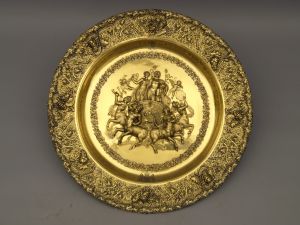MUO-020460: Pladanj: pladanj
Inventarna oznaka
MUO-020460
Naziv zbirke
Književni naziv
Naslov predmeta
Pladanj
Država nastanka
Grad nastanka
Godina nastanka
1815.
Materijal izrade
Tehnika izrade
Opis predmeta
Središnji motiv pladnja predstavljaju zagrljeni Bakho i Arijadna u kočiji, kraj kojih su dva lebdeća putta, a cijela je scena uokvirena vijencem vinove loze s grozdovima. Obod pladnja prekriven je gustim ornamentalnim ukrasima s motivom vinove loze isprepletenim s glazbenim trofejima nadopunjenim bakhantskim glavama. Riječ je o izuzetno reprezentativnom primjerku engleskog srebrnarstva inspiriranom motivima klasične antike.
//
Središnji motiv pladnja predstavljaju zagrljeni Bakho i Arijadna u kočiji, kraj kojih su dva lebdeća putta, a cijela je scena uokvirena vijencem vinove loze s grozdovima. Obod pladnja prekriven je gustim ornamentalnim ukrasima s motivom vinove loze isprepletenim s glazbenim trofejima nadopunjenim bakhantskim glavama. Riječ je o izuzetno reprezentativnom primjerku engleskog srebrnarstva inspiriranom motivima klasične antike.
Nacrt je izveo Thomas Stothard, crtač koji je izvodio skupocjene narudžbe za tvrtku Rundell & Bridge. Nacrt za središnji prizor Stothard je izveo prema predlošku rimske kameje nađene 1660. u Via Aurelia, a koja putem grafičkih listova postaje poznata široj javnosti. Model za pladanj izradio je William Tollemache, a samu izvedbu predmeta preuzela je radionica u Dean Streetu u Londonu koju je vodio Paul Storr.
Iznad centralne scene Bakha i Arijadne gravirani su inicijali EA (Ernest Augustus), a ispod nje je grb vojvode od Cumberlanda, petog sina Georgea III., za kojega je pladanj inicijalno bio i naručen. Koliko je zasad poznato, izrađene su dvije verzije pladnja, s istom središnjom scenom, od kojih prva verzija na obodu ima samo glazbene trofeje (pladanj iz 1813. - 1814.), a kasnije verzije imaju obodni ukras nadopunjen bakhantskim glavama (sva tri kasnija pladnja). Pladanj u Muzeju za umjetnost i obrt izrađen je 1815., prema kompleksnijem predlošku oboda.
Ključne riječi
MUO baza
Autorska prava / Prava korištenja
